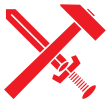Nazi symbolism
| Part of a series on |
| Nazism |
|---|
|
The 20th-century German Nazi Party made extensive use of graphic symbols, especially the swastika,[1] notably in the form of the swastika flag, which became the co-national flag of Nazi Germany in 1933, and the sole national flag in 1935.[2] A very similar flag had represented the Party beginning in 1920.
Swastika[]
The Nazis' principal symbol was the swastika, which the newly established Nazi Party formally adopted in 1920.[3] The emblem was a black swastika (卐) rotated 45 degrees on a white circle on a red background. This insignia was used on the party's flag, badge, and armband. Similar shaped swastikas were seen in United States postcards wishing people good luck in the early 1900s.[4][5]
The black-white-red motif is based on the colours of the flags of the German Empire. This colour scheme was commonly associated with anti-Weimar German nationalists, following the fall of the German Empire.[6] The Nazis denounced the black-red-gold flag of the Weimar republic (the current flag of Germany).[6]
In Mein Kampf, Adolf Hitler described the symbolism of the Nazi flag: "The red expressed the social thought underlying the movement. White the national thought. And the swastika signified the mission allotted to us—the struggle for the victory of Aryan mankind and at the same time the triumph of the ideal of creative work ..."[7]
Today, certain countries such as Germany (see Strafgesetzbuch section 86a), Austria, France, Lithuania, Latvia, Poland, Ukraine, Brazil, and Israel have banned Nazi symbols and it is considered a criminal offence if they are displayed publicly for non-educational purposes. On August 9, 2018, Germany lifted the ban on the usage of swastikas and other Nazi symbols in video games. "Through the change in the interpretation of the law, games that critically look at current affairs can for the first time be given a USK age rating", USK managing director Elisabeth Secker told CTV. "This has long been the case for films and with regards to the freedom of the arts, this is now rightly also the case with computer and videogames."[8][9]
Heraldry[]
Under the Nazi regime, government bodies were encouraged to remove religious symbolism from their heraldry. Symbols such as crosses, saints, etc. were seen as upsetting to the Nazis; however, few German councils actually changed their often ancient symbols. Some, however, did, including Coburg, which replaced the Maure on their arms with a sword and swastika, and Thuringia, which added a swastika to the paws of their lion.[10]
Other symbols[]
Other symbols employed by the Nazis include:
- The eagle atop swastika (German: Reichsadler), the formal symbol of the Nazi Party
- The SS bolts, the runic insignia of the Schutzstaffel[11][12]
- Various runes from the runic script, such as the Odal/Othala, Algiz/Leben, Tyr/Tiwaz runes and other rune-like symbols[13][14] such as the Wolfsangel[15]
- The black SS uniform
- The brown shirts of the Sturmabteilung
- The death's head insignia of the SS-Totenkopfverbände and concentration camp units[16]
- The Black Sun (German: Schwarze Sonne/Sonnenrad) used by Heinrich Himmler of the SS.
- The crossed hammer and sword of Strasserism, a strand of Nazism that has a Third Positionist ideology.
- The broken sun cross swastika.
- The Celtic cross, which was originally a symbol used to represent pre-Christian and Christian European groups such as the Irish, has been used since World War II by many neo-Nazi groups.
Runic letters[]
Letters of the historical runic alphabet and the modern Armanen runes have been used by Nazism and neo-Nazi groups that associate themselves with Germanic traditions, mainly the Sigel, Eihwaz, Tyr;[17] c.f. Odal[18][19] (see Odalism) and Algiz[20] runes.
The fascination that runes seem to have exerted on the Nazis can be traced to the occult and völkisch author Guido von List, one of the important figures in Germanic mysticism and runic revivalism in the late 19th and early 20th centuries. In 1908, List published in Das Geheimnis der Runen ("The Secret of the Runes") a set of 18 so-called "Armanen Runes", based on the Younger Futhark, which were allegedly revealed to him in a state of temporary blindness after a cataract operation on both eyes in 1902.
In Nazi contexts, the s-rune is referred to as "Sig" (after List, probably from Anglo-Saxon Sigel). The "Wolfsangel", while not a rune historically, has the shape of List's "Gibor" rune. Runic "SS" was the symbol of the Schutzstaffel.
Usages by neo-Nazi groups[]
Many symbols used by the Nazis have further been appropriated by neo-Nazi groups, including a number of runes.
Neo-Nazis however also employ various number symbols such as:
- 18, code for Adolf Hitler. The number comes from the position of the letters in the alphabet: A = 1, H = 8.[21]
- 88, code for 88 Precepts. A manifesto written by David Lane, a late 20th-century American white supremacist, on the proper organization of a white nationalist nation, 88 Precepts is a treatise on natural law, religion and politics.[22] However, according to the Anti-Defamation League, it is code for Heil Hitler. Again, the number comes from the position of the letter H in the Latin alphabet.[23]
- 14, from the Fourteen Words coined by David Lane: "We must secure the existence of our people and a future for white children."[24]
- 14 and 88 are sometimes combined with each other (i.e. 14/88, 8814, 1488).[25] They are also sometimes depicted on dice.[26]
Gallery[]

The Parteiadler of the Nazi Party (1933–1945)

SS death's head insignia[27]

Horizontally aligned Wolfsangel, used by the 2nd SS Panzer Division[28]

Vertical Wolfsangel

Odal rune[18][19] (also used by the American-based "National Socialist Movement" since November 2016)[29]

SS Doppel Sigrune

Algiz rune

A simplified version of the Celtic cross is used by various neo-Nazi groups

The broken sun cross used by the German Faith Movement and the 5th SS Panzer Division, also used by the Thule Society[30][31]

The Hammer and Sword utilized by adherents of Strasserism

The Black Sun used by Esoteric Nazi circles and other neo-nazi groups
See also[]
References[]
- ^ "Symbol 34:13". HME Publishing. Archived from the original on 2008-12-08. Retrieved 2008-12-17.
- ^ "Third Reich 1933–1945 (Germany)". Flags of the World. Archived from the original on 2017-11-21. Retrieved 2008-12-17.
- ^ "History of the Swastika". United States Holocaust Memorial Museum. Archived from the original on 12 April 2018. Retrieved 9 May 2018.
- ^ "1910 GOOD LUCK SWASTIKA POSTCARD - Sep 30, 2015 | Affiliated Auctions in FL". LiveAuctioneers.
- ^ "Good Luck Swastika". CardCow.com.
- ^ Jump up to: a b Hilmar Hoffmann, John Broadwin, Volker R. Berghahn. The Triumph of Propaganda: Film and National Socialism, 1933–1945. Berghahn Books, 1997. Pp. 16.
- ^ "text of Mein Kampf". Project Gutenberg. Archived from the original on 2012-04-03. Retrieved 2010-03-02.
- ^ Staff (9 August 2018). "Germany lifts ban on Nazi symbols in video games". The Telegraph. Archived from the original on 9 January 2019. Retrieved 9 January 2019.
- ^ Chalk, Andy (9 August 2018). "Germany Lifts Ban on Swastikas in Videogames". PC Gamer. Archived from the original on 9 January 2019. Retrieved 9 January 2019.
- ^ Slater, Stephen (2003-01-01). The Complete Book of Heraldry: An International History Of Heraldry And Its Contemporary Uses. London, United Kingdom: Anness Publishing. p. 212. ISBN 0754810623.
- ^ "Symbol 34:11". HME Publishing. Archived from the original on 2008-11-22. Retrieved 2008-12-17.
- ^ "Hate Symbols: Neo-Nazi SS Bolt". Anti-Defamation League. Archived from the original on 2008-12-17. Retrieved 2008-12-17.
- ^ "Hate Symbols: Othala Rune". Anti-Defamation League. Archived from the original on 2008-12-17. Retrieved 2008-12-17.
- ^ "Neonazi flag symbolism". Flags of the World. Archived from the original on 2009-01-25. Retrieved 2008-12-17.
- ^ "Wolfsangel". Anti-Defamation League. Archived from the original on 2008-12-17. Retrieved 2008-12-17.
- ^ "Hate Symbols: Neo-Nazi Skull and Crossbones". Anti-Defamation League. Archived from the original on 2013-01-21. Retrieved 2008-12-17.
- ^ "Symbols.com - Symbol 4:22". Archived from the original on Sep 28, 2008.
- ^ Jump up to: a b "Hate Symbols: Othala Rune - From A Visual Database of Extremist Symbols, Logos and Tattoos". Anti-Defamation League. Archived from the original on 21 January 2013. Retrieved 23 April 2015.
- ^ Jump up to: a b "Neo-Nazi flag symbolism". Flags of the World. Archived from the original on 28 December 2014. Retrieved 23 April 2015.
- ^ "Hate Symbols: Life Rune - From A Visual Database of Extremist Symbols, Logos and Tattoos". Anti-Defamation League. Archived from the original on 21 January 2013. Retrieved 23 April 2015.
- ^ "Hate Number Symbols: 18". Anti-Defamation League. Archived from the original on 15 November 2012. Retrieved 23 April 2015.
- ^ "88 Precepts by David Lane - ProudNordicGirl - Wattpad". www.wattpad.com.
- ^ "Hate Number Symbols: 88". Anti-Defamation League. Archived from the original on 6 April 2018. Retrieved 20 March 2018.
- ^ "Hate Number Symbols: 14 (words)". Anti-Defamation League. Archived from the original on 26 October 2012. Retrieved 23 April 2015.
- ^ "Hate Number Symbols: 14/88". Anti-Defamation League. Archived from the original on 26 October 2012. Retrieved 23 April 2015.
- ^ Willingham, A.J. (22 February 2017). "These are the new symbols of hate". CNN. Archived from the original on 20 March 2018. Retrieved 20 March 2018.
- ^ "Hate Symbols: Neo-Nazi Skull and Crossbones". Anti-Defamation League. Archived from the original on 21 January 2013. Retrieved 23 April 2015.
- ^ "Wolfsangel". Anti-Defamation League. Archived from the original on 21 January 2013. Retrieved 23 April 2015.
- ^ Kovaleski, Serge; Turkewitz, Julie; Goldstein, Joseph; Barry, Dan. "An Alt-Right Makeover Shrouds the Swastikas". The New York Times. Archived from the original on 12 December 2016. Retrieved 12 December 2016.
- ^ "Hate Symbols: Celtic Cross". Anti-Defamation League. Archived from the original on 21 January 2013. Retrieved 23 April 2015.
- ^ "Neo-Nazi flag symbolism". Flags of the World. Archived from the original on 28 December 2014. Retrieved 23 April 2015.
External links[]
- Nazi symbolism
- Fascist symbols
- Swastika













